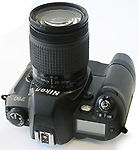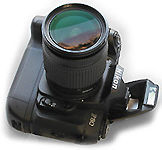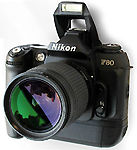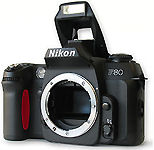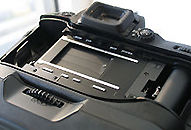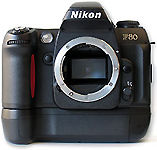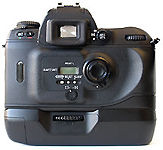Specifications
Type of camera:
Integral-motor autofocus 35mm single-lens reflex with electronically controlled focal-plane
shutter and built-in Speedlight
Exposure modes: P: Programmed Auto (Flexible Program possible); S:
Shutter-Priority Auto; A: Aperture-Priority Auto M: Manual
Picture format: 24 x 36mm (standard 35mm film format)
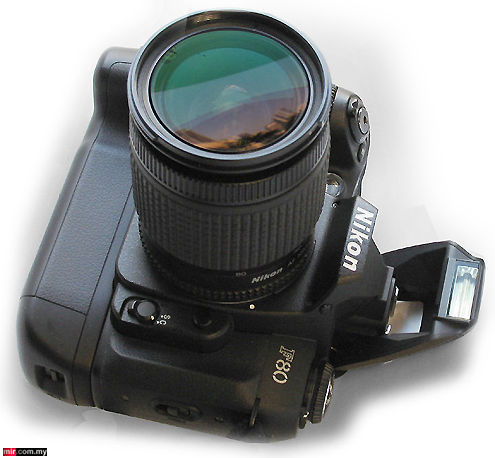 |
|
 |
Viewfinder : Fixed eye-level pentaprism, built-in deportee adjustment (-1.8 to +0.8 DP) Eyepoint 17mm (at -1.0 DP) |
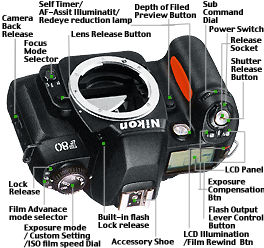 |
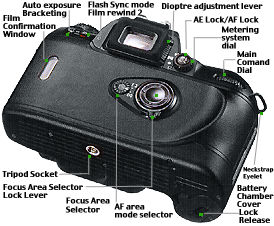 |
Nikon
Introduction |
Credit: My buddy frend from China, Zheng An Guo who has lended me his F80 for me to prepare the images of this site. He is a BIG fan of Nikon... |
||||
Terms of Use : Use these images for whatever purpose that you like - even for your own website, link will be deeply appreciated but not entirely a must. But IF you want to use them for commercial purpose, credit/link should be given because I don't like them to be used for trade/sell reference and it may mislead potential buyers with their actual condition of the said item during an auction sale. For high-resolution images for desktop publishing/advertising, you may make a request via www.Images.com.my
Finder magnification:
Approx. 0.71x - 0.75x with 50mm lens set to infinity
Viewfinder information: Focus indications, metering system AE lock, shutter
speed, aperture, exposure mode, electronic analog exposure display/exposure compensation
display, exposure compensation, frame counter/exposure compensation value, ready-light,
multiple exposure, focus area, flash exposure compensation, five sets of focus brackets
(area) 12mm reference circle for center-weighted metering, On-Demand Grid Lines able
to display
Reflex mirror: Automatic, instant-retum type
Lens aperture: Instant-return. type, with depth-of-field preview button
 |
Autofocus : TTL phase detection, Nikon Multi-CAM900 autofocus module; Detection range: EV -I to EV 19 (ISO 100, at normal temperature) |
 |
Lens servo: Single Servo AF(S), Continuous Servo AF (C), Manual focus (M); Focus Tracking automatically activated in subject's status in Single Servo AF (S) or Continuous Servo AF (C) |
Focus lock: Focus is locked by pressing
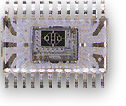 |
Metering system: TTL full-aperture exposure metering system Three metering systems selectable (limitations with lens used) 3D Matrix Metenng; center-weighted Metenng: Approx. 75% of the meter's sensitivity concentrated on the 12mm dia. circle and Spot Metering: 4mm dia. circle (approx. 1% of entire frame) |
Metering range: 3D Matrix Metering: EV 0-21; Centre-Weighted Metering: EV 0-21; Spot Metering: EV 3-21 (at normal temperature, ISO 100, 50mm f/1.4 lens)
Exposure meter: coupling CPU
Exposure compensation: Exposure compensated in +3 EV range, in 1/2 steps
Auto Exposure Lock: Detected exposure value locked by pressing
Auto Exposure Bracketing : Number of shots: two or three; compensation steps: 1/2
Film speed setting: DX or manual selectable; Film speed range: DX: ISO 25-5000, Manual: ISO 6-6400 in 1/3 steps Shutter Electronically controlled vertical-travel focal-plane shutter. The mode/Custom Setting/ISO film speed select dial With this dial, you can select the F80's exposure modes (P, S, A, M) and control the Custom Settings and film speed settings (DX auto or manual).
Shutter speeds: In "P", "A": 30 to 1/4000 sec.; In "S": 30 to 1/4000 sec. (in 1/2 steps); In "M": 30 to 1/4000 sec. (in 1/2 steps), bulb
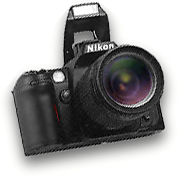 |
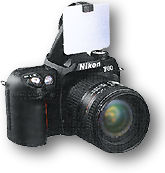 |
Sync contact: X-contact only; flash synchronisation up to 1/125 sec. Built-in Speedlight: Activated by pressing Speedlight lock-release button |
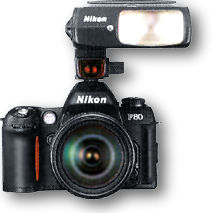 |
Flash control : Controlled by five-segment TTL Multi Sensor Automatic Balanced Fill-Flash with TTL Multi-Sensor: 3D Multi-Sensor Balanced Fill-Flash compatible with built-in Speedlight, SB-28, 27, 26, 25 and D-type Nikkor lens; Multi-Sensor Balanced Fill-Flash with built-in Speedlight or Speedlight such as SB-29, 28, 27, 26, 25, 24, 23, 22s, 22, 20 and AF Nikkor other than D-type or AI-P Nikkor lens (except for the two AF Nikkor lenses designed for F3AF) |
 |
Flash Sync Mode : Front Curtain Sync (Normal sync); Red eye reduction, red eye reduction with slow sync; slow sync, rear curtain sync. |
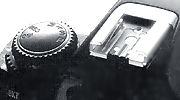 |
Ready-light: Lights up when flash fully charged with built-in Speedlight, SB-28, SB-27, SB-26, SB-23, etc.; blinks (3 sec. after flash) for full output warning |
Self-timer: Electronically controlled; Timer duration: 10 sec.
Depth-of-field preview button: Stop down lens aperture by pressing depth-of-field preview button
Film loading: Film automatically advances to first frame when camera back is closed (shutter and reflection mirror not activated)
Film advance: Automatic advance with built-in motor;
Film advance speed : (with Continuous Servo AF (C), Manual exposure mode,,, shutter speed 1/250 sec. or faster
Imprint data: between film frames not selected for F80S, 36-exposure film):
Film rewind: Automatic rewind with built-in motor;
Rewind speed : with 36 exposures film and 3V lithium batteries: High-speed film rewind: approx. 15 sec., Quiet film rewind: approx. 23 sec.
Multiple exposure: Activated using film advance mode dial
 |
LCD panel information (illumination built-in): DX indication, shutter speed/ exposure compensation value, aperture, exposure compensation, flash exposure compensation, Auto Exposure Bracketing Bracketing bar graphs, Custom, Flexible Program, flash sync mode, AF Area mode, focus area, battery power, frame counter |
Date/time imprint
function (F80D/F80S only): Built-in clock: 24-hour type with timing accuracy
within +/- 90 seconds a month; leap year adjustment until 2049;
Usable film: ISO 32 to 3200 DX-coded film;
Display mode: Year/Month/Day, Day/Hour/Minute, No imprint, Month/Day/Year
and Day/Month/Year;
Shooting data imprint function (F80S only) Selected/canceled with shooting data
imprint dial; Imprinted data: Shutter speed, aperture and exposure compensation value
(selected compensation value); Imprinted location: Between film frames
Camera back: Hinged back with film confirmation window AF Area mode selector,
focus area selector; F80D/F80S: Data imprint LCD panel/buttons; F80S:
Shooting data imprint dial
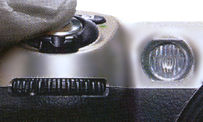 |
QD and Data Imprint versions The F80 is available in a standard version either in chrome white or black in color. There is also a QD version (F80D) that allows you to print the date or time, and a special QD version (F80S) that also imprints exposure data between frames. |
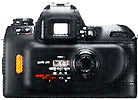 F-80S |
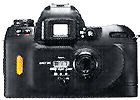 F-80D |
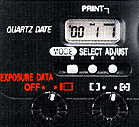 |
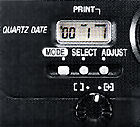 |
Note: Nikon claims F80's film advance speed slows down when exposure data imprinting is selected |
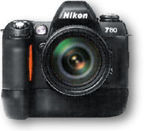 MB-16 MB-16 |
Power source : Two CR123A or DL123A lithium batteries optional Battery Pack MB-16 is also available (for four AA-type alkaline, alkaline-manganese, lithium, NiCd or Ni-MH batteries |
Battery power
confirmation: In LCD panel, with exposure meter on; ![]() : for sufficient power;
: for sufficient power; ![]() : indicates batteries are nearing
exhaustion;
: indicates batteries are nearing
exhaustion; ![]() : Blinking indicates batteries are just about exhausted
: Blinking indicates batteries are just about exhausted
|
Usable
number of 36-exposure film rolls |
At 20°C/68°F |
at -10°C/14°F |
|
Without flash |
Approx. 60 |
Approx. 40 |
|
With flash for half of all exposures |
Approx. 17 |
Approx. 15 |
| * For autofocus operation using an AF Zoom-Nikkor 28-80mm f/3.5-5.6D lens, covering the full range from infinity (oo) to the closest distance and back to infinity (OO) before each shot, with a shutter speed of 1/125 sec. or faster | ||
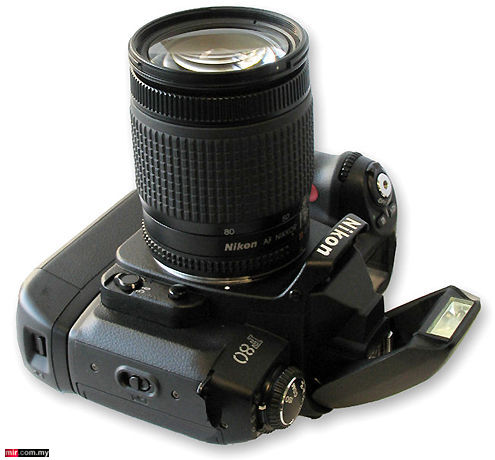 |
Duration of Long Time (Bulb) exposure: Approx. 6 hours [using two 3V lithium batteries at 20°C (68°F) |
Weight (without batteries): F80: Approx. 515g (18.2 oz.); F80D: Approx. 520g (18.3 oz.); F80S: Approx. 525g (18.5 oz.)
Optional exclusive accessories: Battery Pack MB- 16, Soft case CF 59/60
 |
Note: Imprinting exposure data between film feature is only available for Nikon F80S model. |
* Caution: Infrared film cannot be used with this camera, because the F80 detects the film perforation with an infrared ray. The viewfinder image will become slightly darker when batteries are not installed. All specifications apply when fresh batteries are used at normal temperature (20 degrees Celcius). Specifications and design are subject to change without any notice
| Next | Custom Settings and
lens compatibility issues
| Back | Year 2000 introduction of various Nikon
SLRs/Cameras
| Back | Main
Index
Page of
Pictorial History Site
The
Eyes of Nikon:-
Nippon
Kogaku KK Rangefinder
RF-Nikkor
lenses:-
Main Index Page
Nikon
Auto
Focus
Nikkor lenses:- Main Index Page
Nikon
Manual
Focus
Nikkor lenses-
Main Index Page
Fisheye-Nikkor Lenses - Circular | Full Frame |
Ultrawides Lenses - 13mm15mm18mm20mm | Wideangle Lenses - 24mm28mm35mm |
Standard Lenses - 45mm 50mm 58mm | Telephoto
Lenses - 85mm105mm135mm180mm & 200mm |
Super-Telephoto
Lenses - 300mm 400mm 500mm 600mm 800mm 1200mm |
Special
Application lenses:
Micro-Nikkor Lenses - 50mm~55mm -60mm 85mm -105mm 200mm Micro-Zoom 70-180mm
Perspective
Control
(PC) - 28mm 35mm
PC-Micro
85mm
Dedicated
Lenses for Nikon F3AF: AF 80mm f/2.8 | AF 200mm f/3.5 EDIF
Depth
of Field Control (DC): 105mm 135mm
Medical
Nikkor: 120mm 200mm
Reflex-Nikkor Lenses - 500mm 1000mm 2000mm
Others:
Noct Nikkor |
OP-Nikkor | UV Nikkor 55mm 105mm |
Focusing Units | Bellows-Nikkor 105mm 135mm
Nikon
Series E Lenses: 28mm35mm50mm100mm135mm |
E-Series Zoom lenses: 36~72mm75~150mm70~210mm
MF Zoom-Nikkor
Lenses:
25~50mm | 28~45mm | 28~50mm | 28~85mm | 35~70mm | 36~72mm E | 35~85mm | 35~105mm | 35~135mm |
35~200mm | 43~86mm | 50~135mm | 50~300mm | 70~210mm E | 75~150mm E | 80~200mm | 85~250mm |
100~300mm | 180~600mm | 200~400mm | 200~600mm | 360~1200mm | 1200~1700mm
Tele-Converters: TC-1 | TC-2 | TC-200 | TC-201 | TC-300 | TC-301 | TC-14 | TC-14A | TC-14B | TC-14C | TC-14E |
TC-16
|
TC-16A | TC-20E
![]()
Nikon F
| Nikon F2 |
Nikon F3 |
Nikon F4 |
Nikon F5 |
Nikon F6 |
Nikkormat / Nikomat |
Nikon FM
| Nikon FE/ FA | Nikon EM/FG/FG20 | Nikon Digital SLRs | Nikon - Other models
MIR Supports for Photographic Community: Various Message Boards/Community
Forums
Nikon
F-series|
Nikon
F2-series|
Nikon
F3-series|
Nikon F4-series| Nikon
F5-series|Nikkormat/Nikomat-series
Nikon FM-series|Nikon
FE-series|Nikon
FA|Nikon
Digital
SLR
series|Various
Nikon
Models|Nikkor
Optic
-shared
Others:- Free Trade Zone - Photography| Free Trade Zone - Business Community |Free To Zouk - Photographic Community
Apple's Mac Public Community Message Board | Windows based PC &
Apple/Mac
Public Community Trade Exchange Centre
Recommended links to understand
more technical details related to the Nikkor F-mount and production Serial Number:
http://rick_oleson.tripod.com/index-153.html by: my friend, Rick Oleson
http://www.zi.ku.dk/personal/lhhansen/photo/fmount.htm by: Hansen, Lars Holst
http://www.mir.com.my/rb/photography/hardwares/nikonfmount/lens2.htm
http://www.photosynthesis.co.nz/nikon/serialno.html
About
this photographic
site.
Home - Photography
In Malaysia
![]()
Copyright
© 1998. leofoo ®. MIR Web Development Team.
[Left Brain][Right
brain][Home-MIR]
[Invention][Art & Design][Clubs]
[Portfolios][On assignments]
[Trading
room][Knowledge
& Resources]
[Free-trade-zone][Thoughts & opinions][Links]
